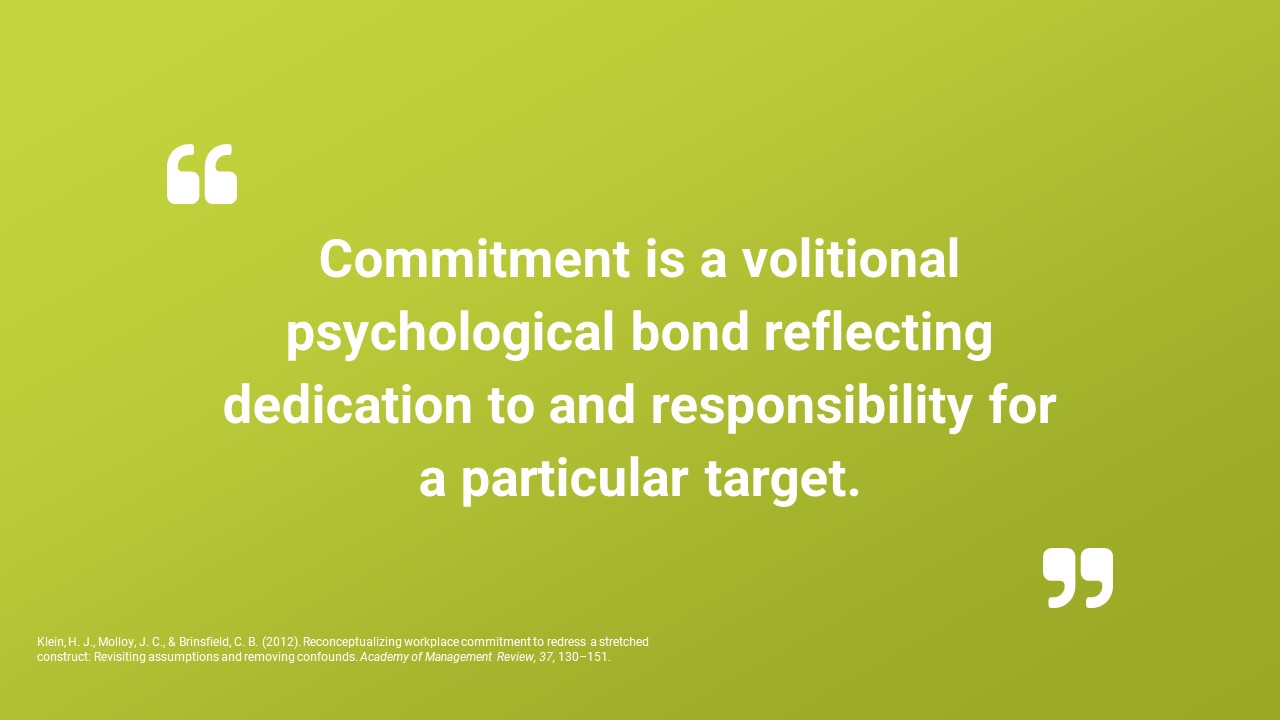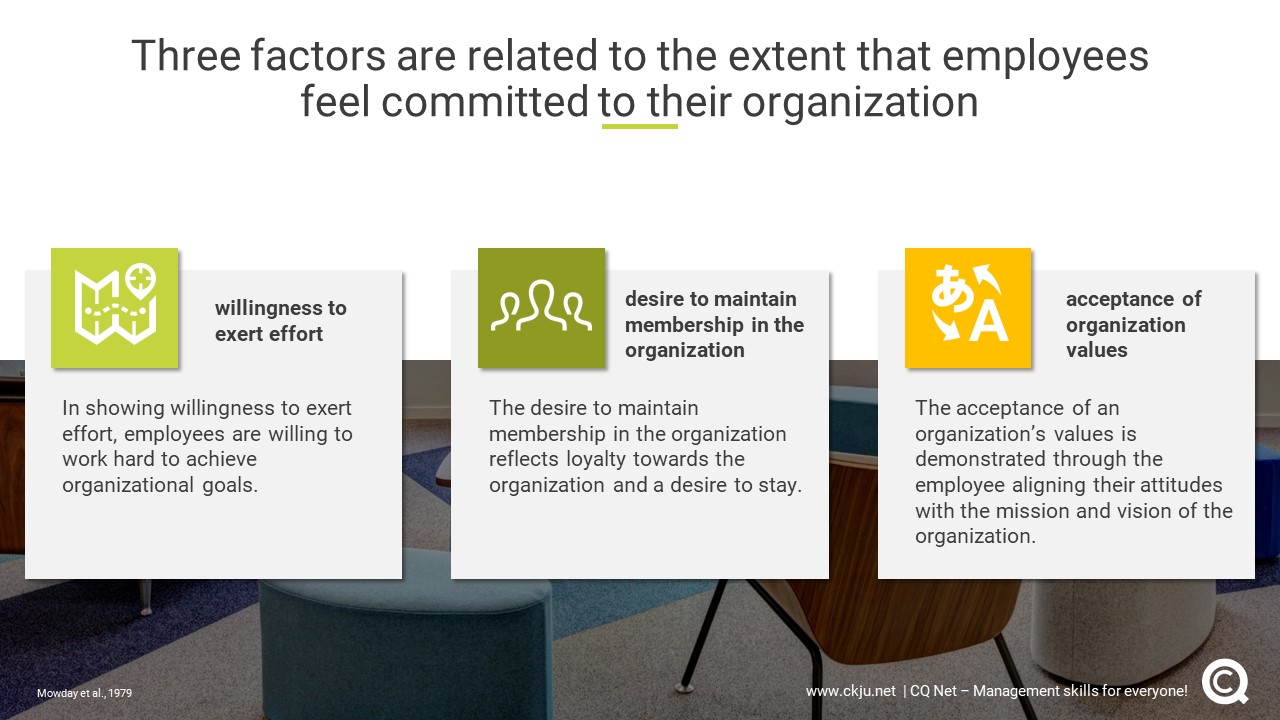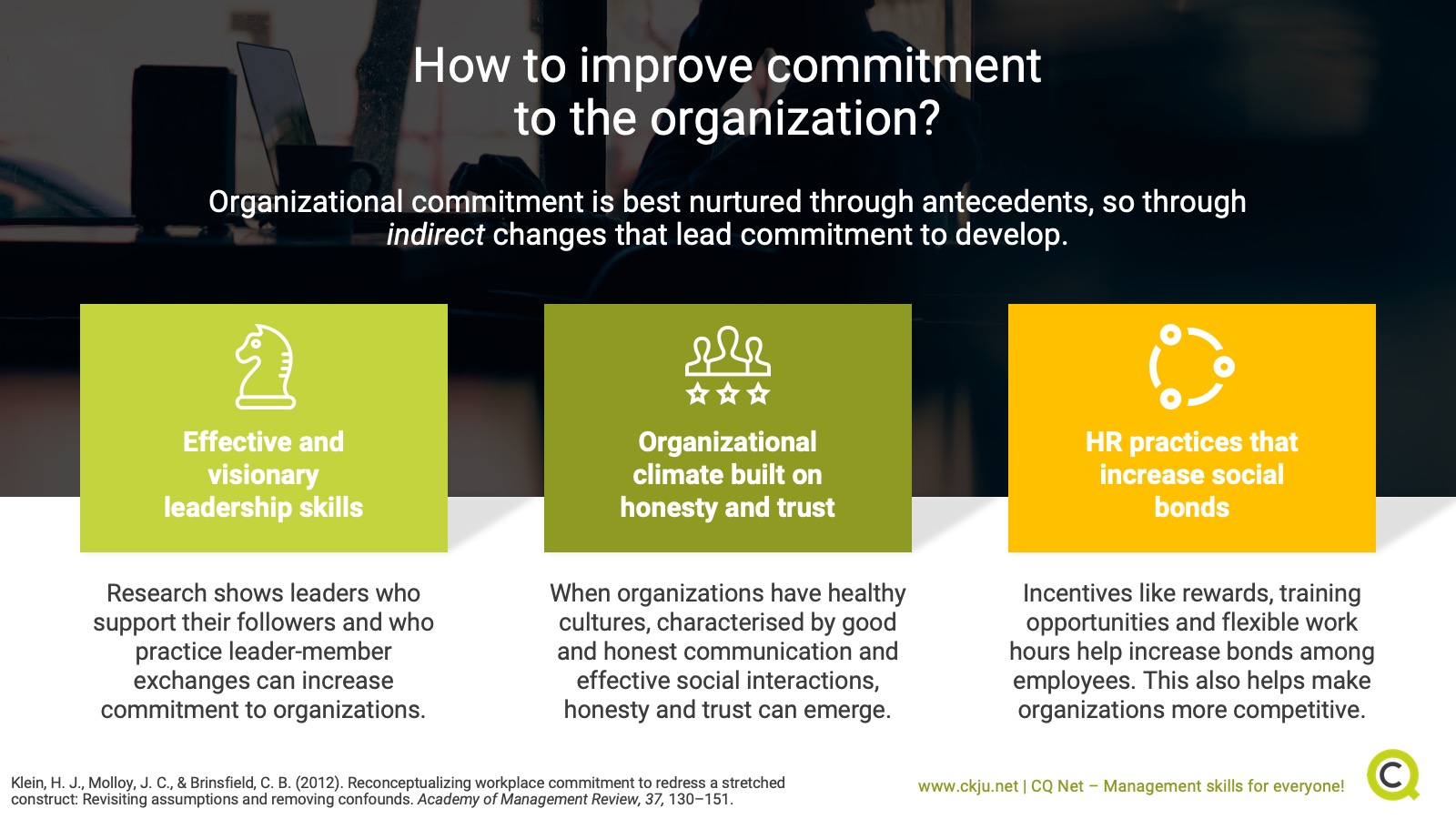- All Management Learning Resources
- Workplace and organizational commitment

Executive summary
In this CQ Dossier we focus on the broad construct of commitment with a special focus on workplace and organizational commitment. First, we provide a definition of commitment and then commitment to the organization. Second, we describe best ways to measure workplace commitment and also focuses on measuring commitment to the organization. Third, we look at the importance of commitment to organizational effectiveness, and commitment to the organization is related to important organizational outcomes. Finally, we introduce a set of recommendations on how to increase commitment to the organization.
Contents
- Executive summary
- What is commitment?
- Commitment refers to a dedication to and responsibility for a particular target
- What is workplace commitment to an organization?
- How to measure workplace commitment?
- Is commitment related to organizational effectiveness?
- What are the best ways to increase commitment?
- Critical appraisal of commitment: Solidity rating 4
- Key take-aways
- References and further reading
What is commitment?
The term commitment refers to the bonds and connections that people make at their place of work (Klein, Molloy & Brinsfield, 2012). These bonds vary in terms of type and target (Klein et al., 2012) with type including continuance, normative, and affective, and target referring to the specific focus of the bond such as the organization, supervisor, work team, projects etc. (Klein et al., 2012).
Continuance commitment refers to have to
Continuance commitment is the degree to which employees believe they have to stay with an organization or other target. For example, an employee might stay with the firm because they need the compensation.
Normative commitment refers to ought to
Normative commitment is the degree to which employees believe they ought to stay committed to a particular target. An example is where an employee feels obligated to stay in an organization.
Affective commitment refers to want to
Affective commitment occurs when the employee wants to be committed to a particular target. For example, if an employee has a high level of affective commitment to the organization, then they have an enjoyable relationship with the organization and are more likely to stay.
Most of the research on commitment has focused on commitment to the organization yet employees can vary into whom they show commitment; it can’t be assumed that commitment to organization also includes a commitment to one’s supervisor (Klein et al., 2012).
Commitment refers to a dedication to and responsibility for a particular target
Commitment should also be differentiated from ‘staying’ with an organization (Klein et al., 2012). To provide a more specific yet holistic view of commitment, Klein and colleagues provide the following definition: "
Commitment is a volitional psychological bond reflecting dedication to and responsibility for a particular target” (Klein et al., 2012).
In providing this definition, Klein and colleagues show that commitment is not necessarily a target-specific conceptualization.
What is workplace commitment to an organization?
Most of the research on workplace commitment has focused on commitment to the organization. Organizational scientists have defined organizational commitment as an individual’s positive emotional attachment towards an organization (Meyer & Allen, 1991).
Traditionally, commitment has been defined as a three-factor model including dimensions of continuance and normative commitment. However, there is research suggesting that affective commitment may be the only ‘true’ commitment because it represents feelings towards the organization rather than behavioral outcomes (Sollinger, Ollfen & Roe, 2008).
How to measure workplace commitment?
The very basis to apply the construct workplace and organizational commitment is to know how to measure it. We are going to have a look at two of the most prominent approaches how to measure in the following section.
The Klein et al. Unidimensional Target neutral (K.U.T) commitment measure
Based on the conceptualization that workplace commitment is a unidimensional, target free construct, Klein and colleagues developed a new measure of commitment (Klein, Cooper, Molloy & Swanson, 2014). The Klein et al. Unidimensional Target neutral (K>U>T) commitment measure consists of 4 items and validity and reliability testing of the measure across over 2,000 participants from different jobs, organizations and industries supported the unidimensional instrument (Klein et al., 2014). The measure is available for researchers and includes these four items:
- How committed are you to (your/the/this) target?
- To what extent do you care about (your/the/this) target?
- How dedicated are you to (your/the/this) target? and
- To what extent have you chosen to be committed to (your/the/this) target?
Organizational commitment questionnaire (OCQ)
There are also other measures of commitment that pertain to specific targets and types. One of the most popular measure of organization commitment is the 15-item Organizational Commitment Questionnaire (OCQ), developed by Mowday and colleagues (Mowday, Steers, & Porter, 1979) that examines the relative strength of an individual’s identification with and involvement in a particular organization. The measure uses a 5-point Likert type response format with a focus on the following three factors (Mowday et al., 1979):
- willingness to exert effort,
- desire to maintain membership in the organization, and
- acceptance of organization values.
The three factors are related to the extent that employees feel committed to their organization.
In showing willingness to exert effort, employees are willing to work hard to achieve organizational goals.
The desire to maintain membership in the organization reflects loyalty towards the organization and a desire to stay.
The acceptance of an organization’s values is demonstrated through the employee aligning their attitudes with the mission of the organization and engaging in behaviors that fit the organization’s vision.
Is commitment related to organizational effectiveness?
In organizations the construct commitment and the saying “he/she is committed to something” is usually connected to positive outcomes such as performance and dedication.
Commitment is related to job satisfaction, identification and turnover intentions
In conceptualizing commitment as a unidimensional construct, Klein and colleagues found that commitment was related to several indices of organizational effectiveness including (Klein et al., 2012)
- job satisfaction,
- identification with the organization, and
- turnover intentions.
Research on commitment to the organization has also demonstrated that this type of commitment is related to organizational effectiveness. Many employees feel committed to their organization and this relationship can affect both parties (Meyer & Allen, 1991). In fact, organizations that treat their employees fairly, reward them, and make them feel like part of a team, report more positive individual and organizational outcomes (Colquitt, 2001).
Affective commitment is related to turnover intentions, absenteeism, and job performance
Several researchers have questioned the relationships between organizational commitment and work outcomes because of the overlap between organizational commitment and other constructs (Klein et al., 2012). To circumvent some of the issues, Luchak and Gellatly (2007) examined both linear and nonlinear relationships between organizational commitment and three work outcomes – turnover intentions, absenteeism, and job performance – across three settings (Luchak & Gellatly, 2007).
The linear model showed that affective commitment was more strongly related to work outcomes, compared to continuance commitment (Luchak & Gellatly, 2007). and this supported previous research.
Organizational commitment impacts workplace outcomes in a non-linear manner
However, when they included continuance commitment as a higher order construct, they found this understated the strength of continuance commitment’s effect on the three work outcomes (Luchak & Gellatly, 2007). So, their research suggests it is important to include continuance commitment as a predictor of work outcomes because previous research failed to account for non-linear effects.
What are the best ways to increase commitment?
To understand and identify how to increase commitment, it is important to focus on antecedents that are linked to commitment and are behavior-based. Klein and colleagues identified several factors that can be changed through organizational interventions including interpersonal factors such as social influence and social exchange and organizational factors such as climate and HR practices (Klein et al., 2012).
Ensure managers and professional are equipped with effective leadership skills
First, organizations can increase commitment through ensuring that employees in managerial positions are equipped with effective leadership skills to influence their subordinates. These skills should include knowledge and practice in leader-member exchanges and how to show support to subordinates (Klein et al., 2012).
Foster an organizational climate that is built on honesty and trust
Second, in order for organizations to gain commitment from employees, it is important to have an organizational climate that is built on honesty and trust. Honesty and trust are built through increasing effective communication and effective social interactions within the organization.
Implement human resource practices that increase bonds among employees
Third, human resource practices can include incentives that focus on increasing bonds among employees such as rewards, socialization efforts, mentoring programs, flexible work hours and training (Klein et al., 2012).
The research on commitment shows that is a viable factor that can influence individual and organizational outcomes. It is important that organizations gain commitment from their employees in order to be competitive in the global market.
Critical appraisal of commitment: Solidity rating 4
Based on the empirical evidence for the evidence of commitment on organizational outcomes, this dossier is assigned a Level 4 rating (based on a 1- 5 measurement scale). A level 4 is the highest rating score for a CQ Dossier based on the evidence demonstrating that commitment is related to organizational effectiveness. Future research needs to focus on utilizing valid and reliable measures such as the measure by Klein and colleagues (Klein et al., 2014) to ensure that commitment is consistent across settings, targets, and types.
Key take-aways
- Commitment refers to the bonds that people make at work
- Commitment is volitional and not target-specific
- Organizational commitment is an individual’s positive emotional attachment towards an organization
- Commitment is related to organizational effectiveness outcomes such as turnover intensions, absenteeism, and job performance
- Commitment can be increased through interpersonal factors, climate and HR practices
References and further reading
Colquitt, J. A. (2001). On the dimensionality of organizational justice: a construct validation of a measure. Journal of applied psychology, 86(3), 386.
Klein, H. J., Molloy, J. C., & Brinsfield, C. B. (2012). Reconceptualizing workplace commitment to redress a stretched construct: Revisiting assumptions and removing confounds. Academy of Management Review, 37, 130–151.
Klein, H., Cooper, J., Molloy, J., & Swanson, J. (2014). The Assessment of Commitment: Advantages of a Unidimensional, Target-free Approach. Journal of Applied Psychology 99, 2, 222-238.
Luchak, A.A., & Gellatly, I. R (2007). A Comparison of Linear and Nonlinear Relations Between Organizational Commitment and Work Outcomes." Journal of Applied Psychology 92. 3, 786-93.
Meyer, J. P., & Allen, N. J. (1991). A three-component conceptualization of organizational commitment. Human Resource Management Review, 1(1), 61-89.
Mowday, R. T., Steers, R. M., & Porter, L. W. (1979). The measurement of organizational commitment. Journal of Vocational Behavior, 14(2), 224–247.
Solinger, O. N., Van Olffen, W., & Roe, R. A. (2008). Beyond the three-component model of organizational commitment. Journal of Applied Psychology, 93, 1, 70.
About the Author






